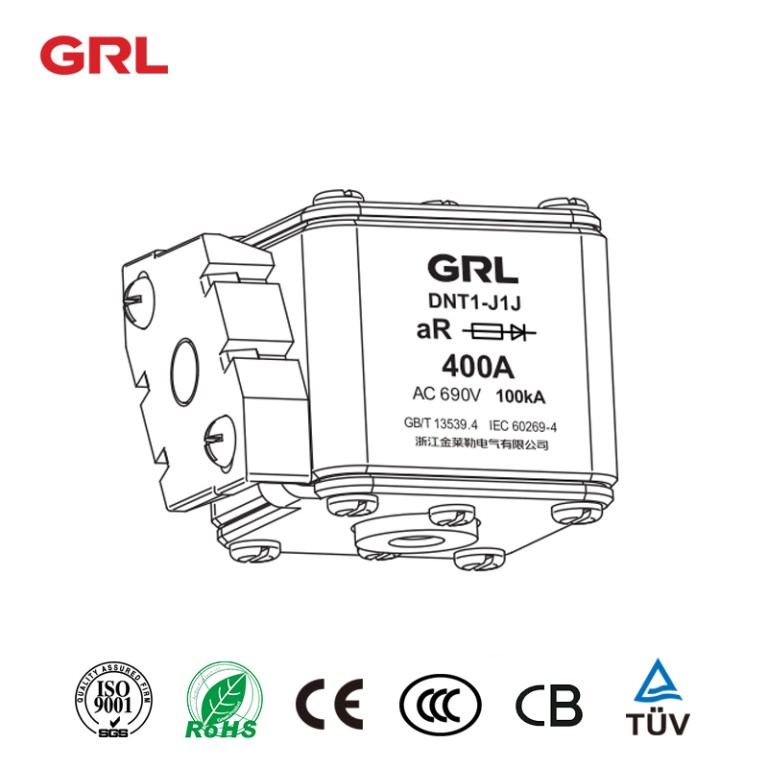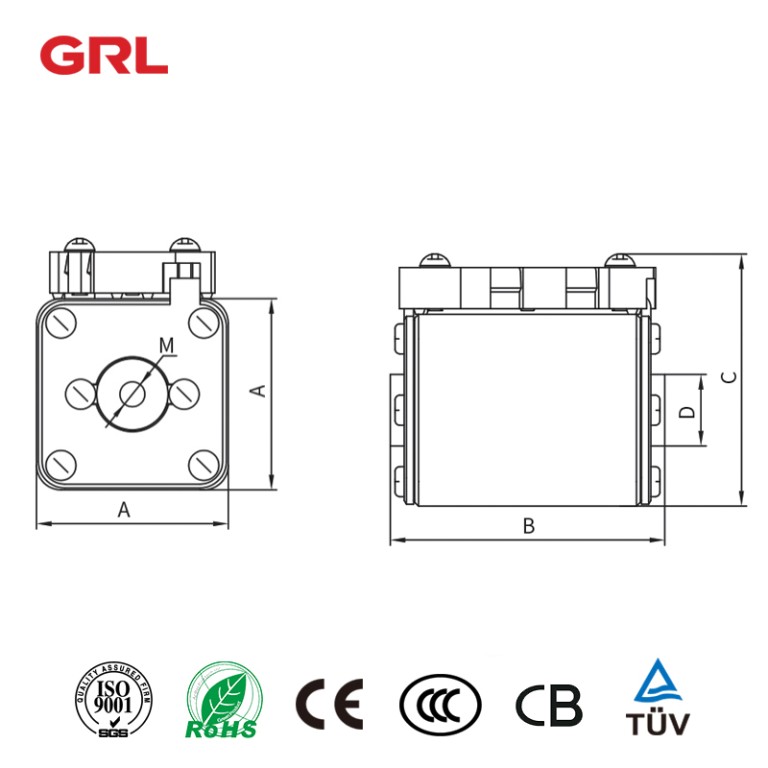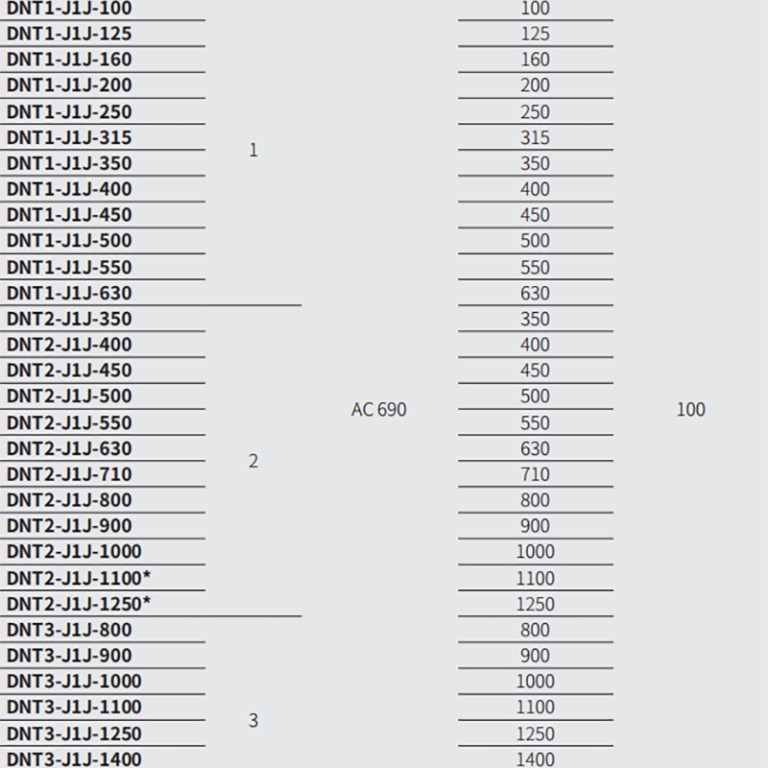Product description
DNT □ – J1J series semiconductor equipment protection fuse
Broken body, suitable for AC systems, rated voltage
690V, rated current between 100A and 1600A, as
Used for short-circuit protection of semiconductor components and their complete equipment.
All performance indicators of the product comply with GB/T 13539.4/IEC 60269-4.
Basic parameters of fuse links
| Product model | size | Rated voltage V | Rated current A | Rated breaking capacity kA |
| DNT1-J1J-100 | 1 | AC 690 | 100 | 100 |
| DNT1-J1J-125 | 125 | |||
| DNT1-J1J-160 | 160 | |||
| DNT1-J1J-200 | 200 | |||
| DNT1-J1J-250 | 250 | |||
| DNT1-J1J-315 | 315 | |||
| DNT1-J1J-350 | 350 | |||
| DNT1-J1J-400 | 400 | |||
| DNT1-J1J-450 | 450 | |||
| DNT1-J1J-500 | 500 | |||
| DNT1-J1J-550 | 550 | |||
| DNT1-J1J-630 | 630 | |||
| DNT2-J1J-350 | 2 | 350 | ||
| DNT2-J1J-400 | 400 | |||
| DNT2-J1J-450 | 450 | |||
| DNT2-J1J-500 | 500 | |||
| DNT2-J1J-550 | 550 | |||
| DNT2-J1J-630 | 630 | |||
| DNT2-J1J-710 | 710 | |||
| DNT2-J1J-800 | 800 | |||
| DNT2-J1J-900 | 900 | |||
| DNT2-J1J-1000 | 1000 | |||
| DNT2-J1J-1100* | 1100 | |||
| DNT2-J1J-1250* | 1250 | |||
| DNT3-J1J-800 | 3 | 800 | ||
| DNT3-J1J-900 | 900 | |||
| DNT3-J1J-1000 | 1000 | |||
| DNT3-J1J-11003 | 1100 | |||
| DNT3-J1J-1250 | 1250 | |||
| DNT3-J1J-1400 | 1400 | |||
| DNT3-J1J-1500 | 1500 | |||
| DNT3-J1J-1600* | 1600 |
* Indicates that the installation size B of the product is different
Appearance and installation dimensions

How have market trends in the semiconductor industry impacted the demand for semiconductor fuses?
The demand for semiconductor fuses is intricately linked to the broader market trends in the semiconductor industry. Here’s how various market trends can impact the demand for semiconductor fuses:
1.Growth in Semiconductor Use: As the use of semiconductors expands across various industries like automotive (especially electric vehicles), consumer electronics, industrial automation, and renewable energy systems, the demand for semiconductor fuses also grows. These fuses are critical for protecting sensitive electronic components from overcurrent and overvoltage conditions.
2.Miniaturization and Integration: The trend towards smaller, more integrated semiconductor devices can have a complex effect on the demand for semiconductor fuses. On one hand, integrated circuits may require smaller, more precise fuses, but on the other hand, the integration of protection features within chips could potentially reduce the need for discrete fuse components.
3.Complexity and Power Density: As devices become more powerful and complex, they often require higher power densities, which can increase the thermal and electrical stress on components, thus potentially increasing the need for robust protection solutions like semiconductor fuses.
4.Supply Chain Issues: The semiconductor industry has faced significant supply chain disruptions in recent years due to factors like trade tensions, the COVID-19 pandemic, and geopolitical issues. This can affect the production and supply of semiconductor fuses, leading to fluctuations in demand as manufacturers try to manage inventory and production schedules.
5.Technological Advances: The development of new semiconductor technologies, such as silicon carbide (SiC) and gallium nitride (GaN), which can operate at higher temperatures and voltages, may change the specifications and demand for semiconductor fuses. These new materials can handle more power and are more efficient, which may necessitate the development of new types of fuses or reduce the need for fuses as devices become more inherently robust.
6.Regulatory and Safety Requirements: As governments and industry bodies introduce new safety regulations, there can be increased demand for semiconductor fuses to ensure compliance. For instance, regulations regarding the safety of automotive electronics or renewable energy systems can drive the adoption of more protective components.
7.Economic Cycles: Economic downturns and upswings can affect the demand for consumer and industrial electronics, thereby impacting the semiconductor industry and the associated demand for semiconductor fuses.
8.Advancements in Circuit Protection Technologies: If new circuit protection technologies emerge that are more effective or cost-efficient than traditional fuses, this could reduce the demand for semiconductor fuses. Conversely, advancements that improve the performance of fuses could increase demand.
the demand for semiconductor fuses is sensitive to the technological, economic, and regulatory landscape of the semiconductor industry. A rise in semiconductor applications generally bodes well for the fuse market, but technological shifts that make circuits inherently safer or that change the nature of circuit protection could temper demand.
Click to view grl group company information>>
Click to view grl fuse link product>>
Click to view fuse base product>>
Click to view fuse holder product>>
leave your question
Get your Comfortable Solution
![]()
GRL Electric Co., Ltd. is one of the leading companies in the Middle And High End market of low-voltage electric in China






